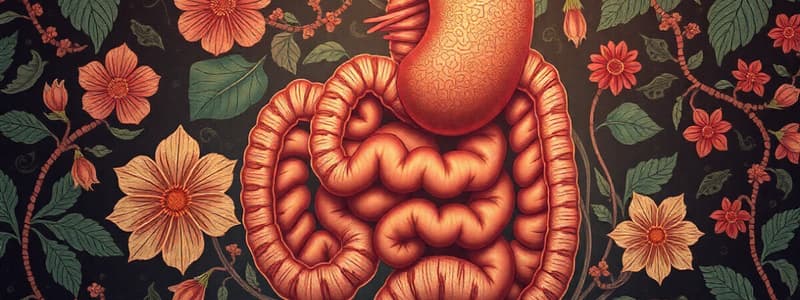Podcast
Questions and Answers
¿Qué son las dislipidemias?
¿Qué son las dislipidemias?
- Alteraciones en los niveles normales de los lípidos en la sangre. (correct)
- Aumento de la producción de bilis en el hígado.
- Alteraciones en los niveles normales de hormonas en la sangre.
- Niveles de colesterol y triglicéridos saludables.
¿Cuál es la función principal del hígado?
¿Cuál es la función principal del hígado?
- Almacenar y concentrar la bilis.
- Absorber nutrientes y agua.
- Producir bilis y procesar toxinas. (correct)
- Producir enzimas digestivas.
¿Qué función desempeña la vesícula biliar en la digestión?
¿Qué función desempeña la vesícula biliar en la digestión?
- Almacenar carbohidratos.
- Absorber nutrientes de los alimentos.
- Concentrar la bilis para la digestión de grasas. (correct)
- Producir hormonas que regulan la azúcar en sangre.
¿Cuál de las siguientes sustancias NO es considerada un lípido según la descripción proporcionada?
¿Cuál de las siguientes sustancias NO es considerada un lípido según la descripción proporcionada?
¿Qué ocurre en el intestino delgado durante la digestión?
¿Qué ocurre en el intestino delgado durante la digestión?
¿Cuál es una de las funciones del páncreas?
¿Cuál es una de las funciones del páncreas?
¿Qué función tiene el intestino grueso?
¿Qué función tiene el intestino grueso?
¿Cuál de las siguientes lipoproteínas debe estar elevada en casos de dislipidemia?
¿Cuál de las siguientes lipoproteínas debe estar elevada en casos de dislipidemia?
Flashcards
Dislipidemias
Dislipidemias
Las dislipidemias son alteraciones en los niveles normales de lípidos en la sangre, como el colesterol y los triglicéridos.
Tipos de Lípidos
Tipos de Lípidos
Grasa neutra, fosfolípidos, colesterol y otros lípidos.
Estómago
Estómago
El estómago es un órgano muscular hueco que almacena temporalmente el alimento, mezclándolo con enzimas.
Páncreas
Páncreas
Signup and view all the flashcards
Hígado
Hígado
Signup and view all the flashcards
Vesícula Biliar
Vesícula Biliar
Signup and view all the flashcards
Intestino Delgado
Intestino Delgado
Signup and view all the flashcards
Intestino Grueso
Intestino Grueso
Signup and view all the flashcards
Study Notes
Dislipidemias
- Dislipidemias are alterations in normal lipid levels in the blood, including cholesterol and triglycerides.
- Elevated levels of CT, LDL, and TG (Lipoproteins) are greater than p90.
- HDL or Apo A-1 levels are lower than p10.
Types of Lipids
- Triglycerides (TG): A type of neutral fat.
- Phospholipids: Lipids with phosphate groups
- Cholesterol: A crucial component of cell membranes.
- Other lipids: Less important in this discussion.
Digestive Organs and Functions
Stomach
- The stomach is a hollow muscular organ.
- It temporarily stores food.
- It mixes food with enzymes.
- It performs mechanical and chemical digestion.
- It empties partially digested food into the small intestine.
Pancreas
- Located behind the stomach.
- Produces enzymes for digesting sugars, fats, proteins, and starches.
- Releases hormones for regulating blood sugar and stimulating stomach acids.
Liver
- Continuously produces bile.
- Aids in fat digestion and nutrient absorption.
- Processes toxins and removes them from the blood.
- Creates substances for blood clotting.
- Maintains healthy blood sugar levels.
Gallbladder
- Small, pear-shaped organ beneath the liver.
- Stores and concentrates bile produced by the liver.
- Aids in breaking down fats into fatty acids during digestion.
Small Intestine
- Breaks down food and absorbs nutrients.
- Moves intestinal contents along the digestive tract
- Absorbs carbohydrates, proteins, and fats.
Large Intestine
- Follows the small intestine to the anal canal.
- Absorbs water and electrolytes.
- Forms stool.
- Facilitates bacterial fermentation.
- Protects against infections.
Rectum and Anus
- The rectum connects the large intestine to the anus.
- Acts as a reservoir for stool before elimination.
- Muscles, nerves, and mucous membranes facilitate healthy bowel movements.
Studying That Suits You
Use AI to generate personalized quizzes and flashcards to suit your learning preferences.



